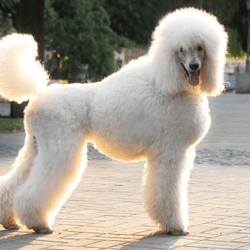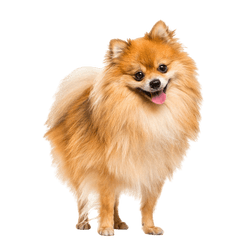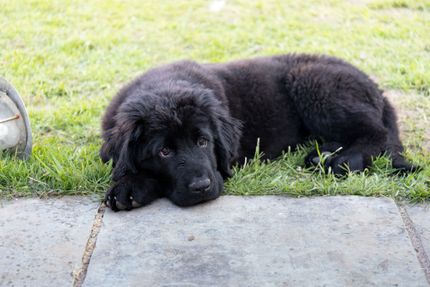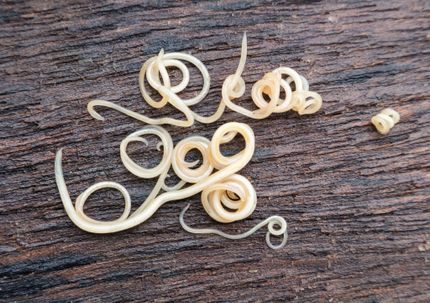Pomapoo:Poodle and Pomeranian Mix
Facts & Origin
Pomeranian and Poodle mix - a hybrid breed
If you're looking for a small, intelligent, and active dog, the Pomeranian-Poodle mix might be just what you're looking for! These dogs are loving and eager to learn and make great companion dogs.
What are breed characteristics of this mix dog?
The Pomeranian-Poodle mix has a small, compact body and a short, dense coat. The coat is usually black, brown or white, and they usually weigh between 3 and 5 kg. They have a thick, fluffy mane around their neck, and their tail is long and curly. Their feet are small and round, and their legs are fairly straight. At the shoulder they usually measure between 25 and 30 cm.
| Alternate Name | - |
| Origin | Germany |
| Life expectancy | 12 - 16 years |
| Care requirements | high-maintenance |
| Activity level | high - low |
| FCI group | not recognised |
| AKC group | not recognised |
| KC group | not recognised |
More Poodle mixes
More Pomeranian mixes
Attitude, character and temperament of the breed
Possible character traits of Pomeranian and Poodle mix - Such is probably his nature.
Pomeranian and Poodle mixes are popular among dog lovers for their small size, hypoallergenic coat and intelligent personality. Often referred to as "Poodle Poms," these dogs are a cross between two popular breeds: the Pomeranian and the Toy or Toy Poodle. Poodle Poms are bred in a variety of colors, including black, white, brown, cream and apricot.
Poodle Poms have a reputation for being intelligent and easy to train. They are also known to be good with children and other pets. However, like all dogs, Poodle Poms need exercise, attention, and lots of love and care from their owners.
Poodle Poms are generally healthy dogs, but like all breeds, they are prone to certain health problems. For example, Poodle Poms can be prone to patellar luxation, where the kneecap (patella) slips out of place. Patellar luxation can be painful and may require surgery to correct. Poodle Poms may also be prone to hip dysplasia, a condition in which the hip joint does not develop properly.
Character
Usage


Health and breeding information
What diseases can occur in Pomeranian and Poodle Mix.
Dogs of the Pomeranian-Poodle mix breed are generally healthy, but like all breeds, they can be prone to certain health disorders. Some of the most common health problems that occur in Pomeranian Poodles are:
- Allergies - Pomeranian Poodles can be prone to allergies, both to food and the environment. Signs of allergies can include itching, scratching, chewing on paws, hot spots, and ear infections.
- Hip Dysplasia - This is a condition in which the hip joint is not properly formed, resulting in pain and lameness. It is more common in larger breeds, but can also occur in Pomeranian Poodles.
- Epilepsy - This is a neurological condition that can cause seizures. It is more common in certain breeds, including Pomeranian Poodle mix breeds, but can occur in any dog.
- Patellar luxation - This is a condition in which the kneecap slips, causing pain and lameness. It is more common in small breeds, and the Pomeranian Poodle is no exception.
While these are some of the most common health problems in Pomeranian Poodles, it is important to remember that all dogs are individual and may not suffer from all or any of these problems. It is always best to consult your veterinarian if you are concerned about the dog's health.
What does this mongrel look like?
This dog has a dense, luxurious coat that is creamy white in color. The Pomeranian-Poodle mix breed is a very elegant looking dog, and its coat is one of its most beautiful features. However, this breed requires a lot of care, as its coat can become matted and matted if not cared for properly.
| Fur length | medium - long |
| Fur | curly - flat coated |
| Ear shape | Floppy Ear - Standing Ears |
| Tail | lang - rolled up |
| Anatomy | slim, sporty, slim, square |
| Size ♀ | 12 - 60 cm |
| Weight ♀ | 2 - 28 kg |
| Size ♂ | 17 - 60 cm |
| Weight ♂ | 2 - 28 kg |
| Suitable For | suitable for allergy sufferers, Beginner, Blind people, Children, Seniors, Seniors |
Known Diseases
Eye diseases
Often occur with allergies and intolerances.
Epilepsy
Definition: Dog has epilepsy if, for example, at least two epileptic seizures occur more than 24 hours apart.
Cataract
Cataracts are still one of the most common causes of blindness, even in dogs.
Patellar problems
Problems with the Patellar can be a displacement or weak kneecap, which is one of the most common causes of lameness in dogs, also because of overweight.
Progressive Retinal Atrophy (PRA)
Progressive retinal atrophy (PRA) is a slowly progressive death of the retina in dogs.
Eye infections
Chronic eye infections can be very painful in dogs and can be treated with medication. In rare cases, the cornea must be treated.
Elbow dysplasia (ED)
Elbow joint dysplasia is a chronic disease complex of the elbow joint of fast growing dog breeds.
Heart disease
Can occur frequently in dogs and can sometimes be treated with medication.
Hip dysplasia (HD)
The hip dysplasia or hip joint dysplasia of the dog (HD) is a maldevelopment of the hip joint.
Patellar luxation
Patellar luxation is the term used to describe a displacement of the kneecap, which is one of the most common causes of lameness in dogs.
Numbness
Often occurs in old age.
FAQ
-
A Pomeranian-Poodle mix is a cross between a Pomeranian and a Poodle. These dogs are usually small and have a coat that is a mix of the Pomeranian and the Poodle coat.
-
One of the advantages of having a Pomeranian-Poodle mix is that they generally don't shed much. This can be a great advantage for those who are allergic to dog hair or who don't want to deal with a lot of hair growth. Another advantage of a Pomeranian-Poodle mix is that they are usually very intelligent dogs. This makes them easier to train than some other dog breeds.
-
One challenge that can come with owning a Pomeranian-Poodle mix is that they require more grooming than some other dog breeds. This is because their coat is a mix of Pomeranian and Poodle coats.
-
A Pomeranian-Poodle mix usually needs moderate exercise. This means that you should take them for a walk or run every day. You can also enjoy playing fetch or other games that require them to run and chase.
Useful Articles

You can find articles that might interest you in the dogbible blog to match your favorite breed.
Visit our magazineto stay up to date on dog trends.
To find out more, view our Privacy Policy
Find here the breed that suits you and find out what character traits it has. Here you can also learn more about the origin, size and weight of your favorite breeds.
Matching your favorite breed, you'll find articles that might interest you on the dogbible dog blog.
Dog and zodiac sign - which breed suits your zodiac sign?
Labrador as a therapy dog - procedure, costs, where, how, what and why just a Labrador
Dog eats pig bones - is it dangerous? Everything you need to know about bones and dogs

















